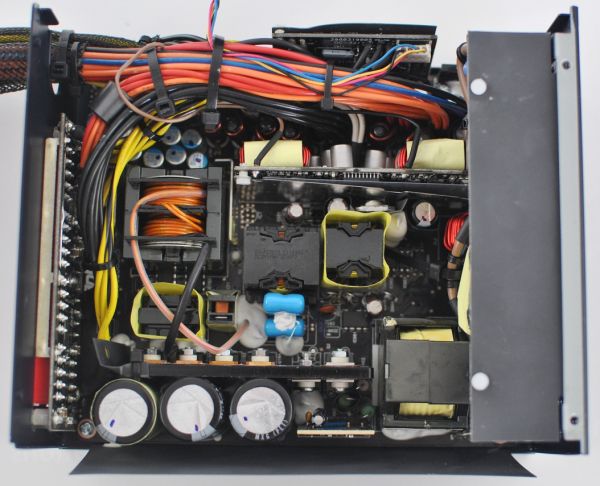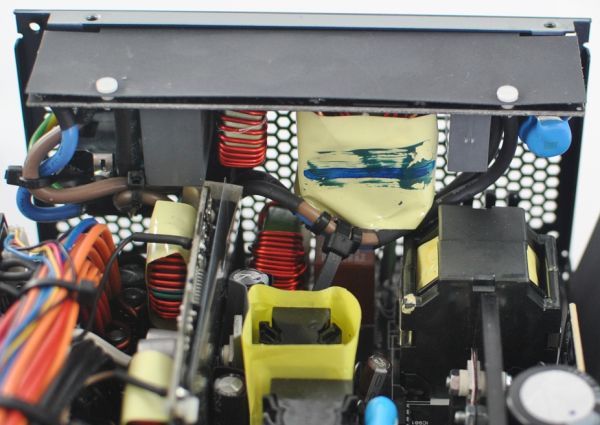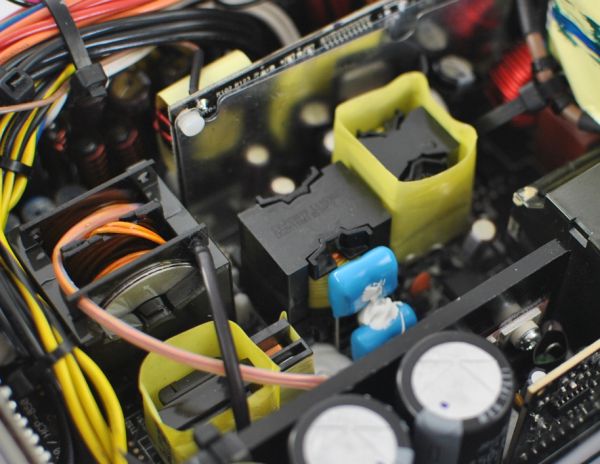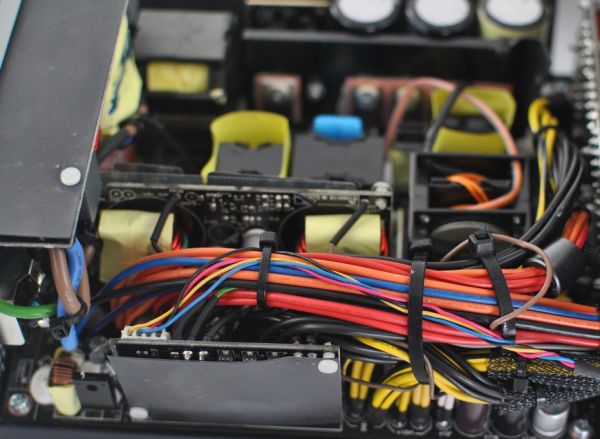Antec HCP-750 80 Plus Gold
by Martin Kaffei on October 26, 2011 4:35 AM EST- Posted in
- Cases/Cooling/PSUs
- PSUs
- Antec
- 80Plus Gold
- 750W
- High Current Pro
Internal Design and Components
The manufacturer for the HCP-750 is Delta Electronics, just like the HCP-1200, but there are clear differences between the two designs. First, Antec uses a resonant converter like Enermax and Seasonic; on the input side, however, a full bridge circuit is used. Furthermore, the model has two major PCBs, where the smaller board is only used for portions of the EMI filtering. Another significant change is that the power supply is cooled vertically by a large fan. It is striking that no rectifiers are installed in the secondary side—at least no THT components and heatsinks. You'll get the detailed description when we take a look on the secondary circuit in a moment. Where needed, a protective foil against short circuits is used. The output wires are grouped together with serveral cable ties.
Behind the AC input are a total of eight Y-capacitors from China, two common mode chokes, two X-capacitors, a linear choke, a MOV, a thermistor, and a relay. Thus the HCP is well equipped in order to suppress interference from the power grid. Both the phase and the neutral conductor have a large wire cross-section. From this point of view it is noticeable that there is not too much space for ventilation. The small additional PCB on top is the reason for this limitation, but the air is pushed down anyway and flows primarily along the board to the outside. Even though some of the upper ventilation holes are blocked, cooling shouldn't be a problem.
The two rectifier bridges with a common heatsink can rectify an alternating current with an RMS value of 25A—at least with the specified ambient temperature and a corresponding size of the heatsink as in the data sheet. In the power factor preregulator we can find three Rubycon capacitors (MXG, 22mm diameter), two Infineon MOSFETs with a low turn-on resistance, and a PFC choke with its own plastic case The FAN6982-IC regulates the current and is designed for continuous current mode (CCM).
The full bridge circuit consists of two half-bridges (two transistors each), which switch alternately. As usual for this variant, the two half-bridges work with the same duty cycle and are phase-shifted. In this case the phase is not the phase conductor, but the phase angle. Thus there is a phase modulation with two time-shifted oscillations through both half-bridges. Especially for a high power output this circuit topology is ideal.
On the output side the full oscillation is rectified, without the need for using a buffer (chokes). Since the resonant circuit makes zero-voltage switching possible, the switching losses are low and the switching frequency can be increased dramatically compared to hard switching topologies.
The four-quadrant operation is crucial for the transformer size, in which not only the first quadrant can be used, but also all negative values (or positive and negative in Q2 and Q4). This is why the transformer and the remaining passive components in this type of converter can be significantly smaller.
Nobody should be concerned by the small main transformer. Here we have a true 750W power supply, and the design principle of this converter is suitable for 1 KW and more. Important for this design is the separate resonant circuit, so no parasitic effects are used to allow ZVS. This could, for example, be the capacitances between two conductors, transformer windings, or between the gate and bulk terminal of the MOSFETs, plus the natural magnetic fields of all conductors and leakage inductivity.
Output side, the two buck converters for +5V and +3.3V are on an additional board. All direct currents run through a circuit made up of rod core inductors and Japanese capacitors. The PCB on the bottom of the 4-pin fan is connected and controlled by the duty cycle. All +12V outputs are protected by OCP, and the cables are fitted with heat-shrink tubing. On the far left we see a small linear regulator for -12V. The MOSFETs for +12V rectification can be found on the back of the main PCB. They are connected via a thermal pad to the housing and can be run almost uncooled at the specified performance. The losses in the semiconductors should be very low.















34 Comments
View All Comments
buzznut - Thursday, October 27, 2011 - link
Wow, sorry to hear that but it kinda sounds like luck of the draw to me. I've used Antec products for quite a while and they've always been high quality.My Antec 650W Blue PSU has been doing well for 3 years and I expect it to continue for at least another 3, probably more.
I've always used WD hard drives, until I had a 500GB green drive fail on me. Now I am skeptical to give them another chance, much like you. I suppose I would give them another shot. On the other hand, the first Foxconn mobo I bought was a piece of crap and I won't bother with that brand anymore.
Trust is something I've always had in Antec products. However PSU dealers like Antec are dependent on the quality of the OEM manufacturer. So, yeah I agree that some of the better Antec and Corsair units have been Seasonic in origin.
SixOfSeven - Wednesday, October 26, 2011 - link
The original Seasonic X-series (X-650, etc.) used PWM fans. I believe the new ones (X-660, etc.) use non-PWM fans. Was the entire rationale for the "new" X-series products just to avoid paying royalties on yet another patent that should never have been issued?Martin Kaffei - Wednesday, October 26, 2011 - link
The new X-Series versions have an improved technology (better MOSFETs, some layout changes, larger heatsinks) too. So I wouldn't say they made new products just because they didn't want to pay for PWM.The Seasonic X-Series is great, since they use Sanyo Denki fans and a semi-passive cooling. Even if there is no more PWM the fan (and fan regulation) is still satisfying.
Btw. Corsair AX (X-750 design) has no PWM. There is definitely a patent for PWM fans in power supplies. Seasonic paid, Corsair not.
ishbuggy - Wednesday, October 26, 2011 - link
Nice article, but could you put captions on your photos? They are nice but not always clear what they are highlighting. Sorry for being nitpicky :PDeath666Angel - Wednesday, October 26, 2011 - link
Hey!Thanks for the review of this item (though I'm not in the market for that much power, prefer the 500-600W range which is sufficient for my single CPU/GPU configurations).
I am going to be buying a new PSU around Christmas and my two current favorites are the Seasonic X-560 or the new be quiet! Straight Power E9 CM. Are you going to be able to review the be quiet? It has a larger fan, is cheaper. The Seasonic has the advantage of being proven and semi-passive. I'd be interested to know how they fair against each other. :-)
buzznut - Thursday, October 27, 2011 - link
Couldn't find a review on the unit you're looking for but it sounds promising, hre's a review on its smaller 400 W sibling:http://www.jonnyguru.com/modules.php?name=NDReview...
Death666Angel - Thursday, October 27, 2011 - link
Thanks for that, but the review is of the E8, which is the predecessor to the E9 which has just been released. The E8 is just bronze/silver, whereas the E9 is all the way gold as far as I can tell. :-)sierraindigo - Wednesday, October 26, 2011 - link
Two references to HCG-750, which is (probably?) a different product.JarredWalton - Wednesday, October 26, 2011 - link
Oops... my bad in editing. High Current Gamer is definitely a different product, though I'm not sure if a 750W model exists. Anyway, I've replaced the references with the HCP. Thanks!buzznut - Thursday, October 27, 2011 - link
Yeah. high current gamer also by Antec. An easy enough mistake.